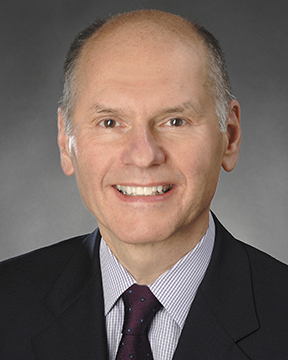By Lisette Hilton
American Academy of Dermatology (AAD) President Bruce H. Thiers, MD, FAAD, and President-elect Kenneth J. Tomecki, MD, FAAD, have their fingers on the specialty’s pulse as leaders of the world’s largest dermatologic society and long-time practicing dermatologists.
The Dermatology Digest asked each dermatologist to share what he thinks are the specialty’s single biggest threat and opportunity. Here is what they had to say.
Today’s biggest threat, according to Dr. Thiers: Loss of control
“The greatest challenge facing dermatology, and indeed all of medicine, is the loss of control, specifically in how we run our practices and how we treat our patients,”said Dr. Thiers, Distinguished University Professor of Dermatology and Dermatologic Surgery at the Medical University of South Carolina, Charleston. “Many of us went into medicine because we expected to make a difference and have the liberty to treat patients in the manner we deemed best. That is no longer the case.”

Many patients still believe their doctors control their treatment or make the decisions about optimal care. That might have been true 20 years ago, but now doctors really just make “suggestions” to outside decision makers, according to Dr. Thiers.
Nowadays, a dermatologist suggests the best course of treatment to the insurance company or the best drug to the pharmacy benefits manager. They are the true decision makers, he said.
“They are the ones who are controlling treatment. In my opinion, insurance companies and pharmacy benefit managers are practicing medicine without a license. To me, this is totally unethical,” Dr. Thiers said.
These companies are motivated by profit, and their goal is to make shareholders happy. One could make the argument that physicians have an incentive to make a profit as well, but they also are bound by the Hippocratic Oath and have a moral obligation to do what is best for their patients. Doctors ultimately have their patients’ best interests in mind and should be in control of decisions about treatment, Dr. Thiers said.
An example of how the decision-making process has gone awry is the oppressive, inefficient process of prior authorization for procedures and drugs. Companies claim prior authorizations control spending on patient medications. For physician practices, this policy increases costs in time and paperwork, with many practices employing people to solely handle prior authorizations. In the meantime, patients wait for care or completely forgo treatment.
Dr. Thiers shared his experience as a patient with prior authorization.
“Maybe a few times a month, I will take the generic version of Ambien if I’m working late and feel a bit too wound up to fall asleep,” he said. “To get the prescription filled, we had to get a prior authorization. The cost of the prescription was $1.13. Think about it: we probably expended $50 to $100 of human capital to get authorization for a prescription that costs $1.13. That is how the system works and how we, as physicians, have lost control.”
Other things erode dermatologists’ control of their practices and patient care. According to Dr. Thiers, electronic health record (EHR) burdens and government programs such as the Merit-based Incentive Payment System (MIPS) top the list.
“With MIPS, we basically have to prove to the government that we are doing a good job treating patients,” he said.
Dr. Thiers argued that a scoring system that impacts physician reimbursement based on areas of care that Medicare deems important suggests there is a cookbook approach to treating patients. There is not, he said. But the MIPS process is yet another hoop the physician must jump through—another obstacle to providing individualized dermatologic care.
Maintenance of Certification (MOC) is another example of a program that many dermatologists believe has little correlation with their ability to practice good medicine. Constant scope-of-practice and truth-in-advertising battles round out a list of distractions that dermatologists face daily and that interfere with their primary purpose: to give patients the best care possible, said Dr. Thiers.
“We have often stood by paralyzed by an inability to act and defend the stature and the independence of the physician. I am not so naïve to think we can reverse this ourselves, but by working with like-minded physicians … from other specialties and concerned legislators I am confident we can begin to turn the tide,” Dr. Thiers said. “Advocacy is the key on both the federal and state levels. Strong state dermatology societies are critical. Get involved!”
The biggest opportunity, according to Dr. Thiers: Dermatology’s growing stature
Major therapeutic advances have elevated dermatology’s stature in the house of medicine since the turn of the century.
These game-changing therapies initially found application in the treatment of inflammatory skin diseases, including biologics for psoriasis and Janus kinase (JAK) inhibitors for atopic dermatitis, as well as treatments for cutaneous malignancies, such as targeted therapies and immune checkpoint inhibitors for melanoma.
“Dermatology was at the forefront of these advances, and since then the same or similar treatments have been shown to help more effectively treat a multitude of other systemic diseases, including rheumatoid arthritis, inflammatory bowel disease, and solid organ tumors, to name a few,” Dr. Thiers said.
Dermatologists also have learned a great deal about the systemic comorbidities that accompany many dermatologic conditions. From a procedural standpoint, dermatologic surgeons display skills in treating skin cancers that are unmatched by any other specialty, according to Dr. Thiers.
“Dermatologists should leverage their well-deserved increased level of respect among our non-dermatologist colleagues to emphasize their importance not only in treating diseases of the skin, hair, and nails, but also in advancing the well-being of the patient as a whole,” he said.
Taking that lead means addressing scope-of-practice issues that affect not only dermatology but also other specialties, according to Dr. Thiers.
”Providers such as nurse practitioners and physician assistants are not the ones who should lead the healthcare team,” he said. “We are physicians, not providers, and we are leaders, not followers. Being at the cutting edge of breakthrough therapies obligates us to work with the house of medicine to ensure that patients understand that their physicians work for them and are ultimately responsible for the decisions that affect their well-being.”
Today’s biggest threat, according to Dr. Tomecki: Reimbursement
“The working premise for most physicians, dermatologists specifically, is that all of us assume that we individually and collectively as a group will receive fair compensation for services rendered, be they surgical, be they pathologic, be they cognitive services,” said Dr. Tomecki, Vice Chairman of Dermatology at the Cleveland Clinic, who will become AAD President for one year beginning in March 2021.

Instead, declining reimbursement is a daily concern for dermatologists and other physicians. And the pandemic has made things much worse.
Physicians in general have taken a financial hit in the last 6 to 8 months because of COVID-19.
“Probably 75% or 80% of dermatologists have been impacted by the pandemic, and patient care has suffered and been compromised because patients cannot make it to office, clinics, etc.,” he said.
Many doctors did not work at all for 3 or 4 months. Income was slashed by more than 70%, according to Dr. Tomecki.
To compound the acute problem of the pandemic and threat of declining reimbursement, the Centers for Medicare & Medicaid Services (CMS) final Medicare Physician Fee Schedule (MPFS) rule for 2020 will go into effect January 2021. Broad changes are proposed, especially with regard to evaluation and management (E/M) services.
“To meet the budget neutrality requirements that are required under the MPFS, the expected increased payments for E/M visits in 2021 will be offset by a decrease in the conversion factor of more than 10%. This decrease will translate into drastic cuts in Medicare reimbursement for dermatology practices and could undermine the financial stability of practices and their ability to serve their patients,” according to AAD (https://www.aad.org/member/advocacy/leg-conference/policy-medicare-physician-payment).
The conversion factor helps determine how much physicians get paid for what they do. The proposed conversion factor will reduce total reimbursement to dermatology by about 2% or 3%. It will hit dermatologic surgeons and dermatopathologists more because of the procedural work they do. Their income reduction would be between 6% and 8%, according to AAD.
“Those folks who do contemplative or cognitive work—they see something, they make a diagnosis, make a recommendation, and write a prescription—they may actually benefit somewhat because there’s going to be an adjustment in payment for the E/M codes. Still, in general, dermatologists will take a hit, some more than others,” Dr. Tomecki said.
Leaders in dermatology and other specialties are asking Congress and the CMS to provide relief from the pending payment cuts as dermatologists and other physicians are just getting back up and running.
Dermatologists took part in the AAD’s annual legislative conference in mid-September making a strong pitch to legislators in Washington D.C. to offset the conversion factor and support legislation that would waive the budget neutrality requirements, according to Dr. Tomecki.
“There’s a fixed amount of money that the government has to move from one pot to another. That is the way it works,” he said. “The AAD favors a waiving of budget neutrality requirements, as planned for January 2021. In same vein, during the 2020 AAD Legislative Conference dermatologist-advocates supported a bipartisan Marshall-Rush letter which asked CMS to delay suggested Medicare cuts. The AAD continues to support efforts to allow Congress more time to consider alternatives.”
“There’s still time to make a correction,” he added.
The major threat now, however, remains the double whammy from the pandemic and potential reduction in reimbursement from the government, he said.
The biggest opportunity, according to Dr. Tomecki: Teledermatology
Telemedicine went from a blip on doctors’ radars before the pandemic to a practice and patient life-line post-COVID-19. While dermatologists have pioneered the technique for decades, its use has been adopted slowly.
“I only started to use teledermatology in the last 3 or 4 months. It fills a niche; it fills a void,” Dr. Tomecki said. “And it’s here to stay.”
Telemedicine’s role had been to provide access to rural and other outlying clinics. NASA has long used telemedicine for medical care on its International Space Station.
In early March Congress passed a law (HR 6074) commonly referred to as COVID Phase One, which allowed for CMS waiver of telehealth restrictions on sites of service, devices, HIPAA compliance, and reimbursement, effectively allowing for telehealth to be used in lieu of in-person case. These waivers hurled telemedicine into the mainstream, with dermatologists and other medical specialties turning to it to care for patients when practices were shut down and later to maintain care but limit person-to-person contact. According to a recent AAD poll, 10% of dermatologists regularly used telemedicine and that number skyrocketed 91% during the COVID-19 public health emergency.
“It has really taken on a life of its own during the last 3 to 6 months,” said Dr. Tomecki. “In dermatology, it probably works best for things like lesions and growths. At least the patient can get a sense of what he or she has on the skin, and the doctor can say, yes, it needs an in-person look and maybe a biopsy, or if it’s a wart or harmless-looking mole maybe the patient can be simply reassured.”
While teledermatology is not expected to take the place of in-person care, Dr. Tomecki said it will likely have a bigger role in practice even if or after the approval and widespread use of a vaccine.
“It allows us to provide some dermatologic care for patients who cannot make it to a clinic or a physician’s office. Hospitals and clinics like it. The government likes it,” he said.
Is it perfect? Far from it, according to Dr. Tomecki.
“For the dermatologist, a live, inpatient visit is always preferable,” he said.

